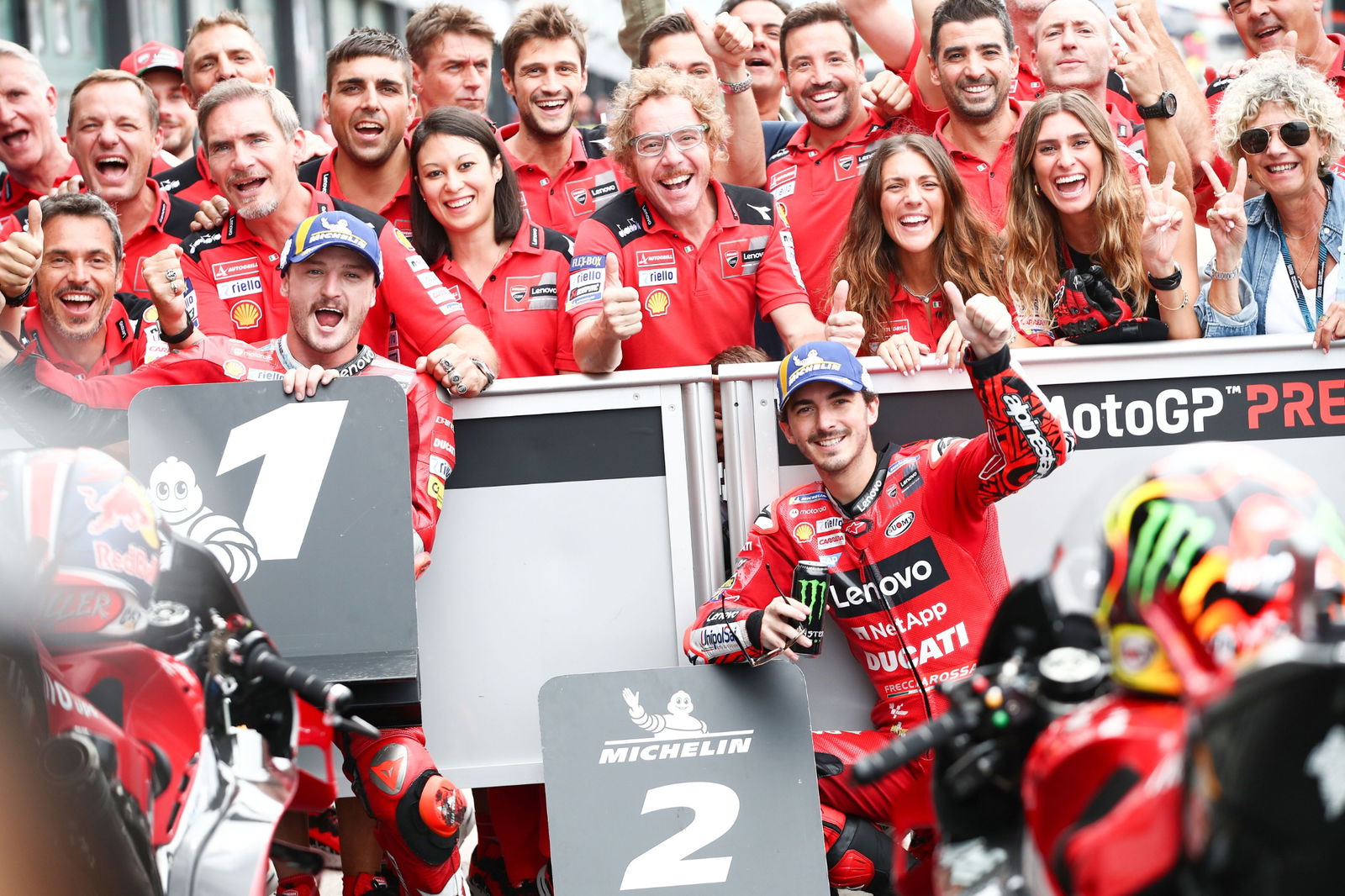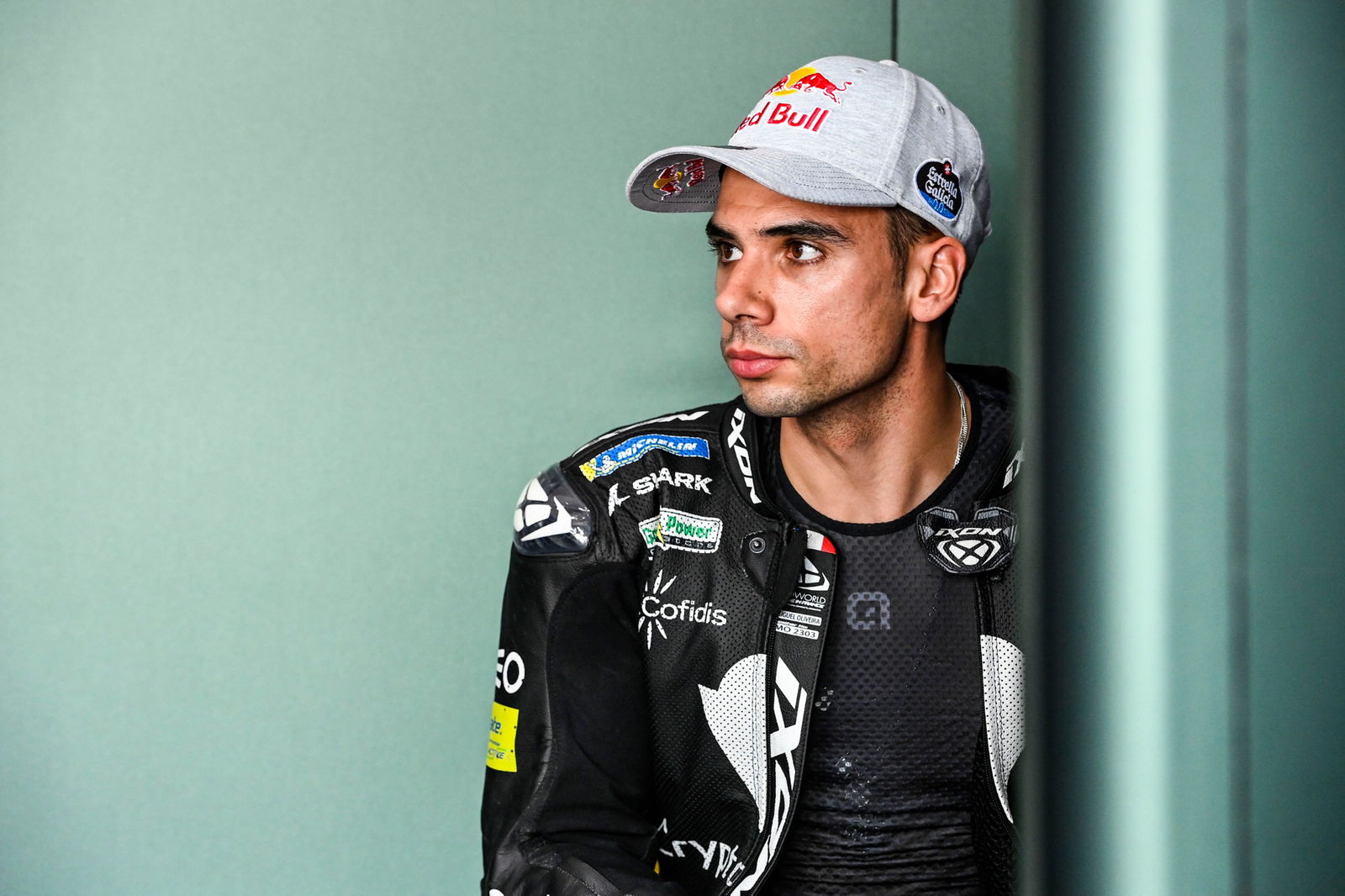MotoGP aerodynamics: Ride-height as ‘DRS’, moveable fairings in future?

That’s the opinion of MotoGP Director of Technology Corrado Cecchinelli, who explained that the change in winglet angle caused by lowering the rear mimics the ‘Drag Reduction System’ in F1.
DRS is used as an overtaking aid by allowing a closely following driver to temporarily tilt the upper rear wing element backwards, slashing drag on the straight and providing a boost of top speed. The wing returns to normal for the following corner when full downforce is required again.
In MotoGP, a rider activates the rear ride-height button before the exit of a slow corner onto a long straight. The rear then drops, tilting the whole bike backwards. This lowers the centre of gravity but also reduces winglet angle and drag.
The ride height returns to normal under braking for the following corner. Unlike in F1, there are no restrictions on how often the system is used per lap, but it's usually around 2-3 times.
- ‘Danger zone’: MotoGP’s new accident detection system explained
- Cancelled laps, DSQ for breaching MotoGP tyre pressures in 2023
- Front ride-height ban ‘correct thing to do’ - rear next?
Ride-height systems began as single-use holeshot devices for the start of a MotoGP race, since lowering the centre of gravity helps reduce wheelies.
Those anti-wheelie gains then spread to slow corners by making the device repeatable, but the rise of advanced aerodynamics means designers are now focussing further along the straight.
“The ride-height device makes a huge difference [to the aerodynamics],” Cecchinelli told Crash.net.
“Of course, the initial scope of the ride-height device and namely the rear ride-height device, is to lower the centre of gravity to reduce wheelies. But I think the aerodynamic effect of using the ride-height device is now more or less of the same magnitude in terms of lap time.
“Because big levels of aerodynamic downforcmeanns you need to pay a lot in terms of drag, which you can reduce by lowering the rear. When lowering the rear you are reducing the aero surfaces rake [angle], so you can save drag exactly when downforce is not needed so much.”
Since high downforce can help reduce wheelies and improve acceleration at the start of a straight, a balance is needed in terms of the point at which drag is reduced.
“It's a compromise for sure, but on a long straight you are talking about gaining tenths of a second by reducing the drag, and wheeling is not an issue for a good part of it,” Cecchinelli said.
“The rear ride-height device is like a natural DRS on a long straight.
“You don't really need a lower centre of gravity in 5th or 6th gear, because you were not wheelieing anyway. But by lowering the rear you have a big advantage in terms of drag.
“Imagine you're exiting an average corner. Aerodynamics is important, but not that much, and so you have a big gain from lowering the centre of gravity to reduce the wheelie.
“The slower the corner, the bigger the gain. But then the faster you go, the bigger the advantage gained by reducing the drag.”
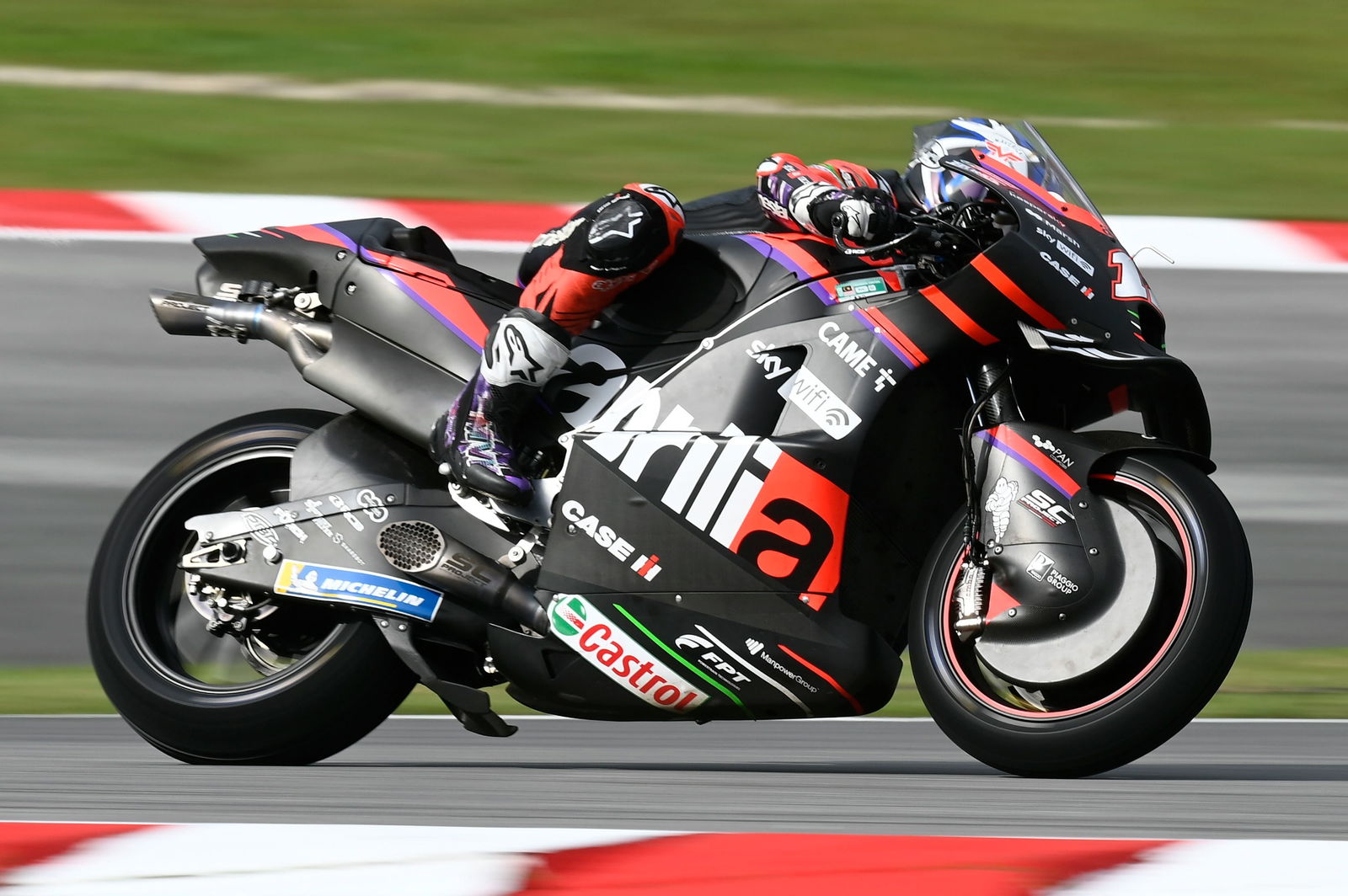
How might a fairing ‘move’ in future?
Given that the rear ride-height device legally changes the angle of the fairing and therefore behaviour of the aerodynamics, let’s look into a crystal ball and consider how the concept might be taken further in future.
MotoGP’s aerodynamic rules are increasingly complicated, but the main guidelines can be summarised as:
- The fairing design (or ‘aero body’ areas) can only be changed once per season.
- ‘Moving aerodynamics devices’ are banned.
In MotoGP terms, ‘moving aerodynamic devices’ includes ‘active’ behaviour, for example adjusting wing angle mechanically on track, and ‘passive’, meaning flexible parts that change angle depending on the speed of the bike. The latter is blocked by the use of a deflection test.
The exact rule on ‘moving’ aero is as follows: ‘Moving aerodynamic devices are prohibited; to this extent, any part of the Aero Body shall be attached so that neither active adjustability is possible (e.g. linkages, bearings and any design that permits an intentional change in shape/orientation/position are not allowed), nor passive; to this extent any part of the Aero Body, when mounted on the bike in normal operating condition, shall have a maximum deflection of 10 mm in any point, when a 50N vertical load is applied in the downward direction with a spherical 20 mm radius steel penetrator.’
In other words, ‘moving aerodynamic devices’ means something that moves independently of the rest of the bike when on track.
The ride-height system is not seen as breaking this rule because the fairing (and all its parts) remains solidly attached to the bike and move 'as one' with the bike.
“Moving aerodynamic devices are not allowed, and we define ‘moving’ as meaning something that moves compared to the chassis and engine,” Cecchinelli confirmed.
“So the rear ride-height device, although it has a big effect on aerodynamics, is not considered as a moving aerodynamic device because the aero body is not moving differently compared to the chassis."
After all, the natural movement of the suspension means the front and rear height of the bike is constantly changing during braking and acceleration, altering the fairing angle.
Likewise, when a team seeks to change the weight balance or handling by raising or lowering the front or rear of the bike in the pits, the fairing 'angle of attack' will also be changed.
With that in mind, would it be possible for teams to mount a fairing onto the bike at different angles in the pits - as long as the fairing design itself wasn’t changed and remained solidly attached to the bike on track?
For example, the fairing could be tilted forwards slightly for a steeper winglet angle (more downforce) or rotated backwards slightly for lower downforce. Perhaps it could even be moved horizontally forwards or backwards a little, again as a form of aerodynamic tuning.
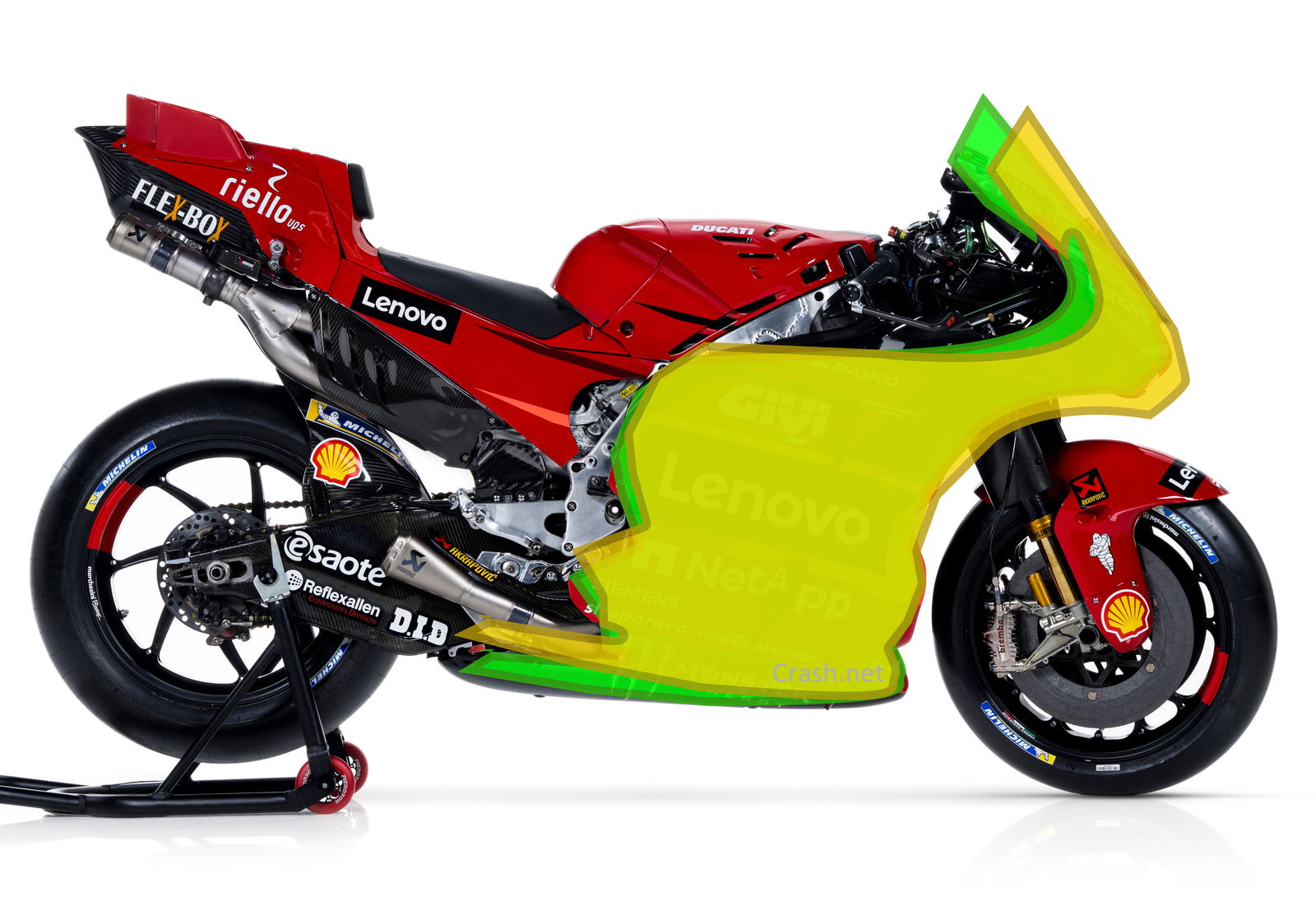
By rotating the fairing when it is mounted onto the bike (yellow, exaggerated) the angle of the aerodynamic surfaces (winglets etc) could be increased or decreased.
With MotoGP aero increasingly focussed on cornering behaviour and ride-height triggered drag reduction, rather than maximum downforce, such tweaking would allow far more aero set-up options for the same fairing.
“Teams could mount [the fairing] at a different angle, but not move it while riding,” agreed Cecchinelli.
“So yes, you can think about making a fairing that can be mounted in different positions, regardless of the technical complication. In principle, it can be done and it's not banned.
“Even if you were mounting the fairing in a different position or angle, this is still not ‘moving’. It would be considered just an adjustment.”
But it’s not known to be done in MotoGP at present, and there’s probably a good reason.
“I don't think [anyone is doing it], but it can be done in principle,” Cecchinelli added.
“I think it's just a bit complicated because you would need to take all that we consider as the aero body and move it on the bike. Which is not that easy for me.
"You can do that in principle, but I see it as a bit difficult.”
Where things would get into more of a grey area is if, by changing the fairing mounting points, a team also manipulated the fairing shape. For example, by pulling certain key areas of the fairing in tighter, or using spacers to push specific parts of the fairing outwards.
In contrast to simply rotating the fairing, or sliding it forwards/backwards a little, such deliberate shape alterations would probably count as a change of fairing design, therefore breaking the homologation rules.
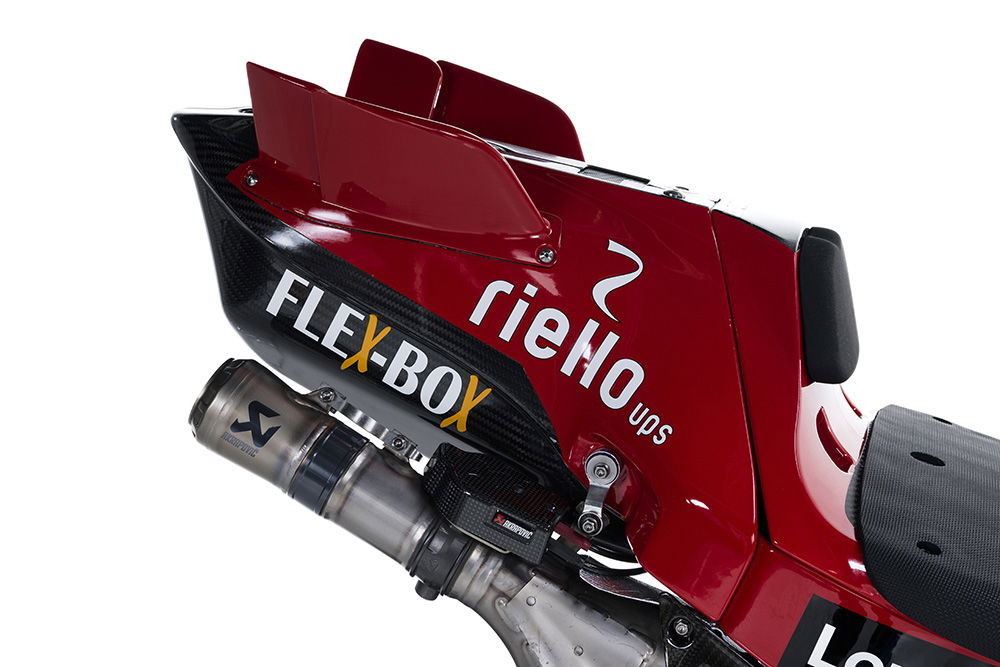
‘Aerodynamics is not a friendly science!’
Unlike engine, electronic and (some) chassis changes, the attraction of aerodynamic developments is that they are visible for all to see.
But working out exactly what those parts are designed to do is sometimes far from clear.
And, as Cecchinelli warned, factories could always indulge in a little technical trickery simply to wrongfoot their opponents.
“Aerodynamics is not a friendly science! You can’t always tell from the shape of something exactly what it is doing,” he said.
“There is even the possibility of a team adding something which is completely useless just to confuse the others!
“You could do that with zero budget, but the others then have to spend money and resources to do their own versions just in case it is a big advantage.”
Front ride-height devices have been banned from the 2023 MotoGP season but the rear system remains legal, along with front and rear holeshot devices for the race start.
